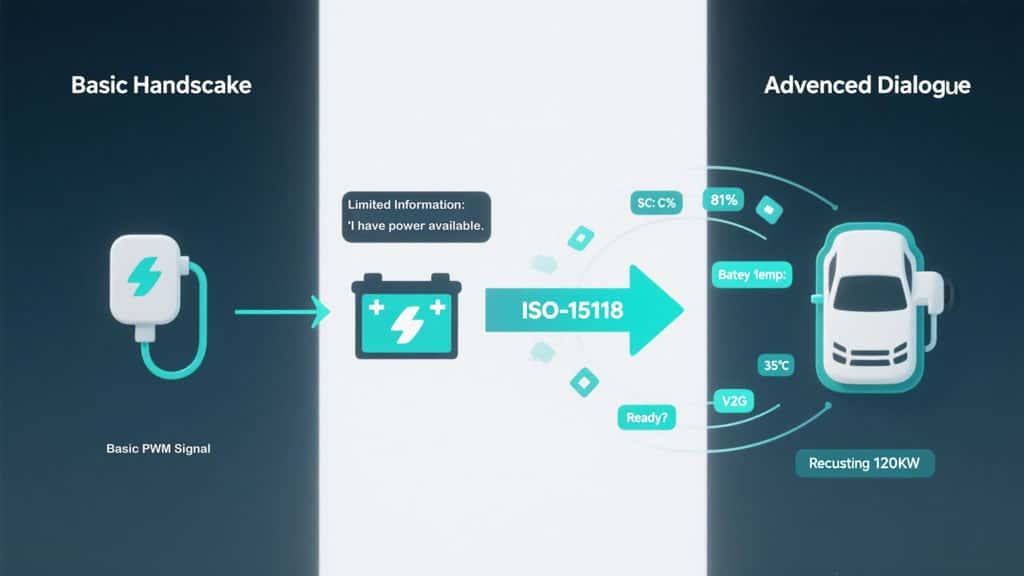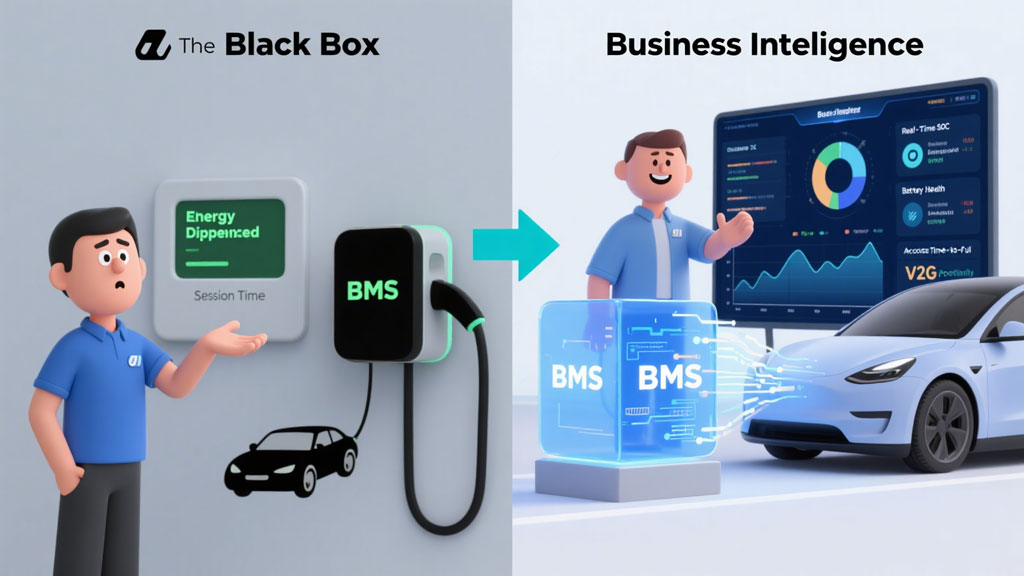As an EV charger operator, you are in the business of selling electricity. But you face a daily paradox: you control the power, but you don't control the customer. The true customer for your charger is the vehicle's EV battery management system (BMS)—a "black box" that dictates if, when, and how fast a car will charge.
This is the root cause of your most common frustrations. When a charging session inexplicably fails or a brand-new car charges at a frustratingly slow speed, the BMS is making the decisions. According to a recent J.D. Power study, 1 in 5 public charging attempts fails, and communication errors between the station and the vehicle are a primary culprit.
This guide will open that black box. We will move beyond the basic definitions found elsewhere. We will explore how the BMS communicates, how it impacts your operations, and how you can leverage it to build a more reliable, intelligent, and profitable charging network.
The BMS Role Inside the Car
First, let's briefly cover what a BMS does internally. This context is crucial. Inside the vehicle, the BMS is the guardian of the battery pack, a complex and expensive component. Its core functions, as outlined by sources like the U.S. Department of Energy, are:
•Cell Monitoring: It acts like a doctor, constantly checking the vital signs (voltage, temperature, current) of hundreds or thousands of individual battery cells.
•State of Charge (SoC) & Health (SoH) Calculation: It provides the "fuel gauge" for the driver and diagnoses the battery's long-term health.
•Safety & Protection: Its most critical job is to prevent catastrophic failure by protecting against over-charging, over-discharging, and thermal runaway.
•Cell Balancing: It ensures all cells are charged and discharged evenly, maximizing the pack's usable capacity and extending its service life.
These internal duties directly command the vehicle's charging behavior.
The Critical Handshake: How a BMS Communicates with Your Charger

The most important concept for an operator is the communication link. This "handshake" between your charger and the vehicle's BMS determines everything. A key part of any modern EV Charging Station Design is planning for advanced communication.
Basic Communication (The Analog Handshake)
Standard Level 2 AC charging, defined by the SAE J1772 standard, uses a simple analog signal called Pulse-Width Modulation (PWM). Think of this as a very basic, one-way conversation.
1.Your Electric Vehicle Supply Equipment (EVSE) sends a signal saying, "I can offer up to 32 amps."
2.The vehicle's BMS receives this signal.
3.The BMS then tells the car's onboard charger, "Okay, you are cleared to draw up to 32 amps."
This method is reliable but provides almost no data back to the charger.
Advanced Communication (The Digital Dialogue): ISO 15118
This is the future, and it's already here. ISO 15118 is a high-level digital communication protocol that enables a rich, two-way dialogue between the vehicle and the charging station. This communication happens over the power lines themselves.
This standard is the foundation for every advanced charging feature. It is essential for modern, intelligent charging networks. Major industry bodies like CharIN e.V. are championing its global adoption.
How ISO 15118 and OCPP Work Together
It's important to understand that these are two different, but complementary, standards.
•OCPP (Open Charge Point Protocol) is the language your charger uses to talk to your central management software (CSMS) in the cloud.
•ISO 15118 is the language your charger uses to talk directly to the vehicle's BMS. A truly smart system needs both to function.
How the BMS Directly Impacts Your Daily Operations
When you understand the BMS's role as protector and communicator, your daily operational problems start to make sense.
•The "Charging Curve" Mystery: A DC fast charging session never stays at its peak speed for long. The speed drops significantly after the battery reaches 60-80% SoC. This isn't a fault in your charger; it's the BMS deliberately slowing down the charge to prevent heat buildup and cell damage.
•"Problem" Vehicles and Slow Charging: A driver might complain about slow speeds even on a powerful charger. This is often because their vehicle has a less capable On-Board Charger, and the BMS will not request more power than the OBC can handle. In these cases, it defaults to a Slow Charging profile.
•Unexpected Session Terminations: A session might end abruptly if the BMS detects a potential issue, like a single cell overheating or a voltage irregularity. It sends an immediate "stop" command to the charger to protect the battery. Research from the National Renewable Energy Laboratory (NREL) confirms that these communication errors are a significant source of charging failures.
Leveraging BMS Data: From Black Box to Business Intelligence

With infrastructure that supports ISO 15118, you can turn the BMS from a black box into a source of valuable data. This transforms your operations.
Offer Advanced Diagnostics and Smarter Charging
Your system can receive real-time data directly from the car, including:
•Precise State of Charge (SoC) in percent.
•Real-time battery temperature.
•The specific voltage and amperage being requested by the BMS.
Drastically Improve the Customer Experience
Armed with this data, your charger's screen can provide a hyper-accurate "Time to Full" estimate. You can also display helpful messages like, "Charging speed reduced to protect your battery's long-term health." This transparency builds immense trust with drivers.
Unlock High-Value Services like Vehicle-to-Grid (V2G)
V2G, a major focus of the U.S. Department of Energy, allows parked EVs to provide power back to the grid. This is impossible without ISO 15118. Your charger must be able to securely request power from the vehicle, a command that only the BMS can authorize and manage. This opens up future revenue streams from grid services.
The Next Frontier: Insights from the 14th Shanghai Energy Storage Expo
The technology inside the battery pack is evolving just as quickly. Insights from recent global events like the 14th Shanghai International Energy Storage Technology and Application Expo show us what's next and how it will impact the BMS.
•New Battery Chemistries: The rise of Sodium-ion and Semi-Solid-State batteries, widely discussed at the expo, introduces new thermal properties and voltage curves. The BMS must have flexible software to manage these new chemistries safely and efficiently.
•The Digital Twin & Battery Passport: A key theme is the concept of a "battery passport"—a digital record of a battery's entire life. The BMS is the source of this data, tracking every charge and discharge cycle to create a "digital twin" that can accurately predict its future State of Health (SoH).
•AI and Machine Learning: Next-generation BMS will use AI to analyze usage patterns and predict thermal behavior, optimizing the charging curve in real-time for a perfect balance of speed and battery health.
What This Means for You?
To build a future-proof charging network, your procurement strategy must prioritize communication and intelligence.
•Hardware is Foundational: When selecting Electric Vehicle Supply Equipment (EVSE), confirm that it has full hardware and software support for ISO 15118 and is ready for future V2G updates.
•Software is Your Control Panel: Your Charging Station Management System (CSMS) must be able to interpret and leverage the rich data provided by the vehicle BMS.
•Your Partner Matters: A knowledgeable Charge Point Operator or technology partner is essential. They can provide a turnkey solution where the hardware, software, and network are all designed to work in perfect harmony. They understand that charging habits, like the answer to How often should i charge my ev to 100?, influence battery health and BMS behavior.
Your Charger's Most Important Customer is the BMS
For years, the industry focused on simply delivering power. That era is over. To solve the reliability and user experience problems that plague public charging, we must see the vehicle's EV battery management system as the primary customer.
A successful charging session is a successful dialogue. By investing in intelligent infrastructure that speaks the language of the BMS through standards like ISO 15118, you move beyond being a simple utility. You become a data-driven energy partner, capable of providing smarter, more reliable, and more profitable services. This is the key to building a network that thrives in the decade to come.
Post time: Jul-09-2025


